| Organic Seeds | Edible Plants | Organic Pest Controls | Books | Tools, Propagation & Fertilisers | Sprouting & Microgreens | Poultry Supplies | Specials & Gift Ideas |

Top

We will send an email to this address*
when is next available
* we will use this email address only for this notification and then we will delete it.
 Home
Home
Green Harvest Organic Gardening Supplies is permanently closed as of 5pm on 1-11-2023.
We will not be taking orders by this website, in person, by phone or email. Our display garden and retail shop are closed forever.
Read more...
Phone:07 54357000
Phone calls will only be responded to sporadically and only in reference to orders placed prior to 2-11-2023. All the useful growing and organic pest management research and resources are available on this website for a while still.
|
Cossack Pineapple Cranberry Hibiscus Cucamelon Curry Leaf Tree Curry Plant |
|
Preparing your planting area ahead of time is very worthwhile - for detailed growing
notes, click the link next to each plant.
List of all plant growing information |
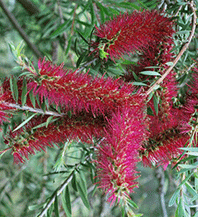 Callistemon 'Genoa Glory'
Callistemon 'Genoa Glory'

 UT
UTCallistemon forresterae Not to Norfolk Island, NT, SA, TAS or WA An excellent choice as a medium sized screening shrub with beautiful dark magenta pink flowers that attract honeyeaters. It can be used as an informal hedge or for habitat enrichment. It is a fast growing, evergreen shrub, 1 to 2 metres tall by 0.6 to 1 metres wide. It does well across most climate zones. Callistemons are tolerant of a wide range of soil types and growing conditions. It flowers best in a full sun position but will cope with some shade. Always give bottlebrush a good prune after flowering to encourage new growth and more flowers. Provided as tubestock. GC218 GC219Save $1.90 |
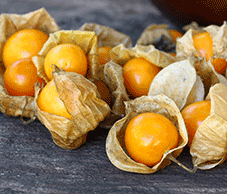 Cape Gooseberry
UT
Cape Gooseberry
UTPhysalis edulis syn. P. peruviana Not to Norfolk Island, NT, SA, TAS or WA Syn. golden berry. A short-lived perennial to 1 metre high, producing a large quantity of sweet, juicy, marble-sized golden yellow fruit encased in a lantern. Eat fresh or as jam. Cape Gooseberry is prone to pest problems in the subtropics so is best grown in more temperate areas. Provided in 100 mm pots. GC129 Available as seed... |
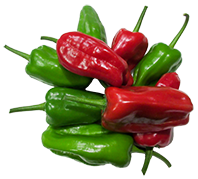 Capsicum 'Perennial'
UT
Capsicum 'Perennial'
UTCapsicum annuum Not to Norfolk Island, NT, SA, TAS or WA 'Perennial' is a tall, hardy, productive, bush capsicum that can live up to 5 years in the tropics. The fruit are 3 cm by 8 cm long and taper to a blunt point, ripening from green to red. It is resistant to wilt and can also be used as rootstock for grafting other capsicum varieties. Days to harvest: 70. Provided in mini pots. GC115 GC131Save $1.90 Available as seed... |
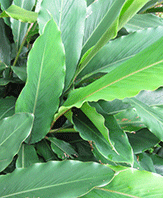 Cardamom - True
UT
Cardamom - True
UTElettaria cardamomum Not to Norfolk Island, NT, SA, TAS or WA Cardamom is a member of the ginger family and native to tropical regions. It is a tall growing, to 3 m high, perennial spice plant that forms a very large clump over time. It does not tolerate very cold conditions or frost. Cardamom likes to grow in filtered light with regular watering. It prefers a rich, mildly acidic, loamy soil. The fresh leaves can be used to flavour rice but the main harvest is the small green seedpods containing one of the world's most expensive spices by weight. The spice is a common ingredient in Indian and Scandinavian cooking. In the Middle East it is used as a traditional flavouring in coffee and tea. Time to harvest: 3 years to produce seed pods. Provided as a rhizome per pack. GC123 |
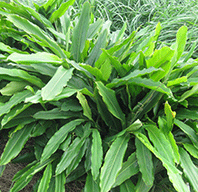
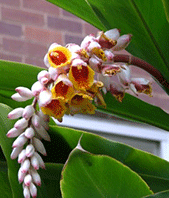 Cardamom Leaf Ginger
UT
Cardamom Leaf Ginger
UTAlpinia nutans Not to Norfolk Island, NT, SA, TAS or WA Syn. shellflower, dwarf cardamom, false cardamom. Cardamom Leaf Ginger is one of the hardiest members of the ginger family with a wide range of uses. The plant forms good-sized clumps fairly rapidly and can be used as a 1 m tall screen. The evergreen foliage is attractive and can be used to create a tropical feel. The leaves have a very distinctive cardamom fragrance when crushed, although this is not the plant that produces the cardamom pods. Use the leaves in desserts; to add flavour to steamed rice, or to wrap fish. In a herbal tea they are delicious combined with lemongrass and ginger. The flowers are white, shell-like sprays and bloom prolifically. They are considered edible and can be used in salads or preserved in sugar to decorate cakes.The plants are surprisingly drought tolerant and resistant to pests and diseases. It will grow in full sun but prefers partial shade. One of our favourite uses is to cut and gather armfuls of fragrant leaves for mulching. Provided as tubestock. GC136 GC137Save $1.90 |
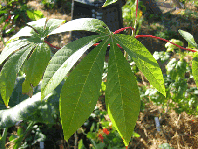 Cassava
UT
Cassava
UTManihot esculenta Not to Norfolk Island, NT, SA, TAS or WA Syn. tapioca. A large, 3 to 4 metre high, woody shrub with enlarged tuberous roots, very widespread food plant in the tropics and subtropics. Suitable for subtropical to tropical areas. More info on growing cassava... Provided as tubestock. GC108 GC121Save $1.90 |
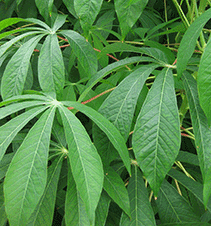
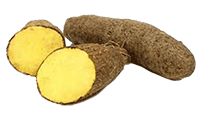 Cassava 'Yellow'
UT
Cassava 'Yellow'
UTManihot esculenta Not to Norfolk Island, NT, SA, TAS or WA Syn. tapioca, yuca. Yellow cassava is a large, 3 to 4 metre high, woody shrub with edible tuberous roots. It is similar to common or white cassava but has a higher nutrient content and is generally higher yielding. It is a very widespread food plant in the tropics and subtropics. Suitable for subtropical to tropical areas. More info on growing cassava... Provided as tubestock. GC197 |
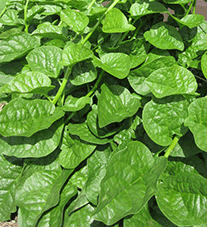 Ceylon Spinach
UT
Ceylon Spinach
UTBasella spp Not to Norfolk Island, NT, SA, TAS or WA Syn. malabar spinach. Attractive climbing vegetable, leaves are rich in vitamins, minerals and chlorophyll, eaten raw or cooked; perennial in the tropics. Suitable for subtropical and tropical areas. Provided in mini pots. GC112 GC113Save $1.90 Are you looking for Ceylon spinach seed? |
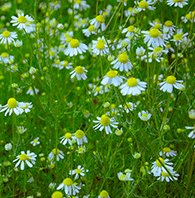 Chamomile - English
Chamomile - English

 UT
UTChamaemelum nobile Not to Norfolk Island, NT, SA, TAS or WA Syn. Roman chamomile, lawn chamomile. English Chamomile is a perennial low-growing herb to 25 cm with feathery green leaves and small, sunny daisy flowers. Both the leaves and flowers have a delightful, fresh, apple scent. The flowers are used to make a relaxing herb tea and as a hair rinse. Harvest the chamomile flowers when fully open, they can be used fresh or dried and stored for later use. Famous for use as a lawn but there is a lot of weeding involved. It does best in areas with cool summers. Suitable for temperate areas; in subtropical areas it requires partial shade and will be short-lived; it is unlikely to grow in tropical areas. Provided in mini pots. GC158 GC159Save $1.90 Available as seed... |
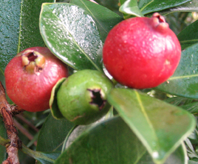 Cherry Guava syn. Strawberry Guava
UT
Cherry Guava syn. Strawberry Guava
UTPsidium littorale syn. P. cattleianum Not to Norfolk Island, NT, SA, TAS or WA Cherry Guava is an evergreen shrub with white flowers that bloom in late spring. Fruit is round, plum-sized, deep wine-red, with a very thin skin. The flesh is juicy with a sweet flavour. Cherry guavas dislike low temperatures but will tolerate some frost and are hardier to cold than the common guava. The fruit can be eaten raw and is high in Vitamin C; it is also used in jellies, drinks and jams. The plant is useful as a fruiting hedge, poultry forage and windbreak. More info on growing cherry guava... Provided as tubestock. GC111 GC140Save $1.90 Available as seed... |
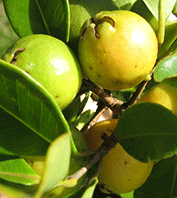 Cherry Guava 'Gold'
UT
Cherry Guava 'Gold'
UTPsidium littorale syn. P. cattleianum Not to Norfolk Island, NT, SA, TAS or WA Cherry Guava 'Gold' is a less common form of cherry guava but otherwise grows in a similar way. It is an evergreen shrub with white flowers that bloom in late spring. Fruit is round, plum-sized, golden yellow, with a very thin skin. The flesh is juicy with a sweet flavour. Cherry guavas dislike low temperatures but will tolerate some frost and are hardier to cold than the common guava. The fruit can be eaten raw and is high in Vitamin C; it is also used in jellies, drinks and jams. The plant is useful as a fruiting hedge, poultry forage and windbreak. More info on growing cherry guava... Provided as tubestock. GC170 GC171Save $1.90 Available as seed... |
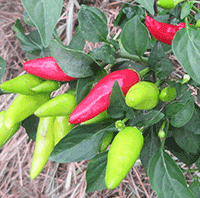 Chilli 'Birdseye Thai'
UT
Chilli 'Birdseye Thai'
UTCapsicum annuum Not to Norfolk Island, NT, SA, TAS or WA 'Birdseye Thai' is a must for every keen cook of South East Asian and Indian food. A productive chilli with upright clusters of fruit, approximately 5.5 - 6 cm long, with thin walls and an intense spicy flavour. The fruit start green and ripen to deep red. A good choice to grow in a container as plants are compact. Very hot: 100,000 to 225,000 Scoville. Provided in mini pots. GC185 Available as seed... |
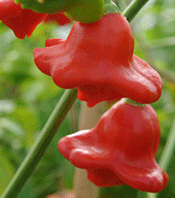 Chilli 'Bishops Crown'
UT
Chilli 'Bishops Crown'
UTCapsicum baccatum Not to Norfolk Island, NT, SA, TAS or WA Syn. christmas bell, bishop's hat. A bushy chilli plant 75 cm high with unusual-shaped fruit. Very hardy, it will grow from the tropics right through to Tassie. It is highly productive and tolerant of poor soils. The fleshy fruit is spicy, crisp and fruity so is a good choice for chilli sauce. Days to harvest: 90 days for green fruit; 100 days for red. Scoville heat scale 5,000 - 30,000 units. Provided in mini pots. GC182 GC183Save $1.90 Available as seed... |
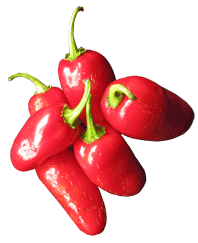 Chilli 'Jalapeno'
UT
Chilli 'Jalapeno'
UTCapsicum annuum Not to Norfolk Island, NT, SA, TAS or WA 'Jalapeno' chillies taper to a blunt end, are 7.5 cm long and 3 cm in diameter. The fruit are glossy deep green in colour, turning bright red when ripe. The plants are sturdy and productive over a long period and begin cropping early. Plants also grow well in containers. It is a good choice for salsa and dishes where a milder chilli is preferred. Days to harvest: 65 days for green fruit; 85 days for red. Scoville heat scale 5,000 units. Provided in mini pots. GC201 Available as seed... |
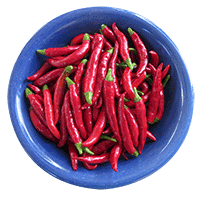 Chilli 'Paprika'
UT
Chilli 'Paprika'
UTCapsicum annuum Not to Norfolk Island, NT, SA, TAS or WA 'Paprika' looks a lot like 'Birdseye Thai' but the mild, spicy taste is completely different. It has long, red, narrow fruit to 7 cm long. Use it fresh or it can be dried and ground into powder or strung along string to dry. The hardy bushes grow to around 70 cm tall and take a while to start producing but continue to fruit over a long period. Days to harvest: 100 days. Scoville heat scale 4,000 units. Provided in mini pots. GC134 Available as seed... |
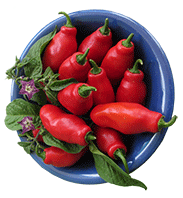 Chilli 'Rocoto Tree'
H
UT
Chilli 'Rocoto Tree'
H
UTCapsicum pubescens Not to Norfolk Island, NT, SA, TAS or WA Syn. hotlips, locoto, manzano. This is a true heirloom, having been grown for thousands of years by the farmers of Bolivia and Peru. A 'must have' plant for anyone who likes really hot chillies, it grows well from the tropics right through to Tassie (in a suitably sheltered position). It is considered the most cold-tolerant of the chillies. The fruit is produced on a sturdy, wide, bushy, perennial shrub up to 2 - 3 m tall. It has small, dark purple flowers and dark green leaves with a purplish tinge. Highly productive, it crops nearly year round with fruit that start as green turning purple and then glossy bright red when fully ripe, the seeds are black. It is hardy and pest resistant including fruit fly but like all chillies, sensitive to heavy frost. Fruit ranges from medium hot to extremely hot depending on the weather. The fruit is fleshy like a capsicum so is a good choice for chilli sauce. Days to harvest: 95 days for green fruit; 130 days for red. Scoville heat scale 100,000 - 300,000 units. Provided in mini pots. GC152 Available as seed... |
|
Scoville Scale
The Scoville scale is a measure of the 'hotness' of a chilli pepper or anything made from chilli peppers, i.e. Tabasco sauce (2,500 - 5,000 Scoville). The scale is named after Wilbur Scoville who developed the test in 1912. |
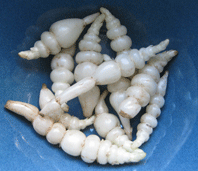 Chinese Artichoke
UT
Chinese Artichoke
UTStachys affinis Not to Norfolk Island, NT, SA, TAS or WA Syn. artichoke betony, crosne. The tuber is eaten as a root vegetable and is creamy white and tender with a nutty, artichoke-like flavour. The tubers grow to 6 cm long and have a fascinating spiral shape, like a sea shell. The plant is easy to grow but the yield of tubers can be small and the plant spreads aggressively. We recommend you use large planter bags. Provided as tubers (3). GC106 Provided as tubestock. GC127 GC128Save $1.90 |
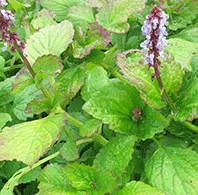
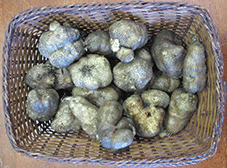 Chinese Potato
UT
Chinese Potato
UTPlectranthus rotundifolius syn. Solenostemon rotundifolius Not to Norfolk Island, NT, SA, TAS or WA Syn. hausa potato, native or country potato in Africa. This unusual and rare herbaceous perennial plant produces egg-shaped edible tubers which can be cooked just like a potato although the flavour is slightly sweeter. It is surprisingly easy to grow, good to eat and nutritious. It is suited to fertile, moist soils in full sun although it will grow in partial shade. It will also grow well in a large pot, which is recommended, as it can become weedy. Plants take 5 - 7 months from planting to harvesting the tubers, the tubers deteriorate rapidly if left in the soil too long. Chinese Potato is native to the moist tropics so does best in warm climates. In very hot climates it will do better with shade protection. It is propagated from tubers although it can be grown from cuttings. Suitable for warm temperate, tropical and subtropical areas. Provided as tubers (3). GC196 Provided as tubestock. GC179 |
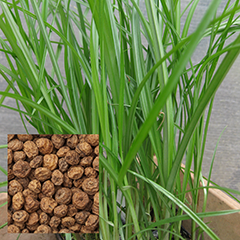 Chufa 'Jumbo'
UT
Chufa 'Jumbo'
UTCyperus esculentus var. sativus Not to Norfolk Island, NT, SA, TAS or WA Syn. tiger nut, atadwe, yellow nutsedge, earth almond, mundo horchata. A grass-like plant to 0.9 m tall grown for its small tubers, which vary between pea-sized and grape-sized. The tubers have a slightly sweet, nutty flavour and are eaten raw or cooked, or ground into flour. As a botanical relative of nutgrass Chufa is naturalised in Australia. It needs to be grown in a container and will be hard to remove if planted in a garden bed. Provided as tubestock. GC199 GC200Save $1.90 |
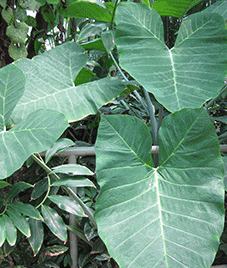
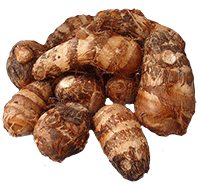 Cocoyam
UT
Cocoyam
UTXanthosoma sagittifolium Not to Norfolk Island, NT, SA, TAS or WA Syn. eddoe, tannia, arrowleaf elephant ear, malanga, American taro, yautia. Cocoyam is a root vegetable grown through the humid subtropics and tropics related to taro. It is a productive, low maintenance and attractive plant. The edible parts are the young leaves, young stems and potato-like cormlets (similar to tubers), which all need to be boiled before eating. The central large corm is not edible but is used as animal feed or to propagate new plants. The large, dark green leaves are heart-shaped with pale green succulent stems, which can grow 1 to 2 m high. Plants prefer full sun to light shade, well drained fertile soils with a pH of 5.5 to 7. Space plants about 80 cm apart. Provided as a tuber. GC102 |
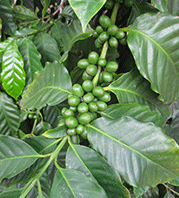 Coffee Arabica
UT
Coffee Arabica
UTCoffea arabica Not to Norfolk Island, NT, SA, TAS or WA An ornamental, glossy leaved, evergreen shrub that covers itself in fragrant small white flowers. Following the flowers, red berries appear which are harvested for the coffee beans inside. Coffee is a hardy plant that will grow in partial shade in any fertile, well drained soil. It does best in subtropical and relatively frost-free temperate climates so will grow along most of the eastern coastline of Australia. It is useful as an understorey plant, as a hedge or in a large container. It will also grow as an indoor plant but is unlikely to fruit. Provided as tubestock. GC173 GC174Save $1.90 |
|
A Kama is a light-weight Asian-style sickle which is ideal
for cutting mulch plants.
|
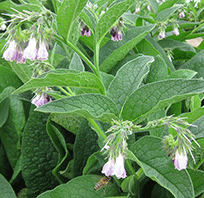 Comfrey
UT
Comfrey
UTSymphytum officinale Syn. boneset. Comfrey is an herbaceous perennial plant widely used as an animal forage, soil improver, bee forage and mulch plant. It has large, hairy leaves and grows in a rosette to 1 metre in height. The mauve flowers are bell-like and borne in clusters. Comfrey rarely flowers in subtropical and tropical areas as there isn't sufficient winter chill to induce flowering. In cold areas it is dormant in winter. It is a hardy plant, with a wide climatic range, from cool temperate to tropical. It provides high yields on fertile, well-watered soil. Comfrey probably has the widest range of uses in a permaculture system of any plant. More info on growing comfrey... Provided as root cuttings. Not to Norfolk Island, NT, TAS or WA GC138 GC139 Provided in mini pots. Not to Norfolk Island, NT, SA, TAS or WA GC103 GC119Save $1.90 |
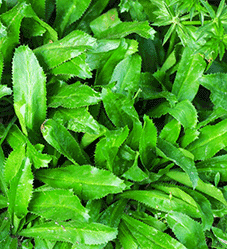 Coriander - Mexican
UT
Coriander - Mexican
UTEryngium foetidum Not to Norfolk Island, NT, SA, TAS or WA Syn. culantro, saw-leaf herb, sawtooth herb, long coriander. Mexican Coriander is a low growing plant with a rosette growth habit to 40 cm high. The leaves are stiff, long and deeply toothed; the flowers are spiky. It is a short-lived, frost tender perennial; treat it as an annual in cool areas. It has a very similar flavour to coriander but is much more able to cope with hot, humid weather. It is a better choice for subtropical and tropical areas than common coriander as it also dries well and stands up to cooking. The leaves are used fresh or dried in curries, salads, chutneys and salsa. It grows well in containers and prefers partial shade. Provided in mini pots. GC132 GC133Save $1.90 Available as seed... |
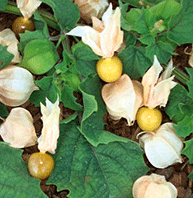 Cossack Pineapple
Cossack PineapplePhysalis pruinosa Syn. ground cherry. A true heirloom vegetable, recorded as early as 1837. It is a warm season, frost tender perennial, a close relative of the Cape gooseberry with a sweet, pineapple like flavour. It can be grown as an annual in cooler areas. It is easy to grow with a low, sprawling, bushy habit to 50 cm high. Wait for the ripe fruit to fall to the ground, the fruit will be blueberry-sized, golden yellow and the papery husk tan-coloured at maturity. It should not be eaten green. Use it fresh or cooked in pies, jams, salsas and desserts. It is prone to pest problems in the subtropics and grows best with an exclusion cover. Days to harvest: 77. Available as seed... |
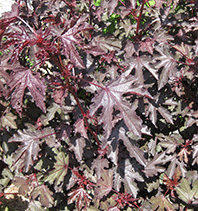
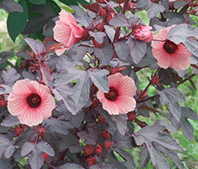 Cranberry Hibiscus
UT
Cranberry Hibiscus
UTHibiscus acetosella Not to Norfolk Island, NT, SA, TAS or WA Syn. African rosemallow, false roselle, maroon mallow, Florida cranberry. A short-lived perennial shrub for the subtropics and tropics; grown as an annual in cooler climates. It has deeply cut, cranberry red, edible leaves that can be used raw or cooked. More info on growing cranberry hibiscus... Provided as tubestock. GC109 GC120Save $1.90 |
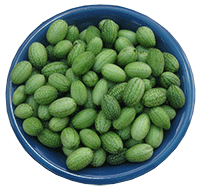
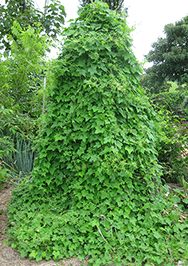 Cucamelon
H
UT
Cucamelon
H
UTMelothria scabra Not to Norfolk Island, NT, SA, TAS, VIC or WA Syn. mexican sour gherkin, mouse melon, sandita. An heirloom vegetable from Mexico that crops abundantly. Fruit are about the size of grapes, look like a tiny watermelon and taste like lemony cucumbers. The older fruit can become quite sour. Eaten raw in salads, used in stir-fries or pickled, they are popular with children. Very hardy and drought-tolerant, unlikely to be damaged by pests and diseases. It may self-sow the following year. Provided in mini pots. GC215 GC216Save $1.90 Available as seed... |
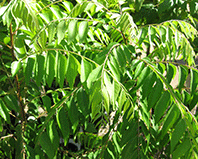 Curry Leaf Tree
UT
Curry Leaf Tree
UTMurraya koenigii syn. Bergera koenigii Not to Norfolk Island, NT, SA, TAS or WA Syn. sweet neem, curry leaves. This is a small bushy tree to 4 m high that does well in the subtropics and tropics. It has attractive, fragrant white flowers and dark, ferny leaves. In colder areas it can be grown in a container and moved indoors or onto a sheltered verandah during winter. It is considered an essential spice in many Indian and Sri Lankan dishes and has been used as a herbal medicine for centuries. The leaves have a spicy flavour and are used in curries, chutneys and marinades. Dried leaves are sometimes an ingredient in Madras curry powder. When cooking, the leaves are stripped from the stems and added to hot oil at the beginning with the other spices. The plant prefers rich, well-drained soil in a warm, sheltered position with consistent watering during dry periods. It both self-sows and suckers so care must be taken to prevent any weed potential. We recommend growing it in a large pot or planter bag. As birds may spread the berries, the berries should be removed by giving the plant a trim once it finishes flowering before the berries are fully formed. Provided as tubestock. GC161 GC166Save $1.90 |
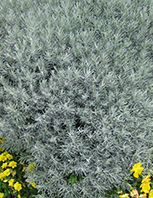
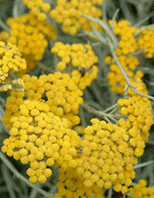 Curry Plant
UT
Curry Plant
UTHelichrysum italicum syn. H. angustifolium Not to Norfolk Island, NT, SA, TAS or WA Curry Plant is an evergreen low shrub growing to 0.6 m high with a 1 m spread, it is native to the Mediterranean. The low grey mounds are very attractive and dense enough to prevent weeds coming through. It prefers a well-drained soil with a position in full sun and will not grow in shade. The clusters of bright yellow button flowers appear in summer, and as they retain their colour after picking can be used in dried flower arrangements. An essential oil is made from the flowers with a wide range of medicinal uses. The oil is used as a fixative in perfumes and has an intense fragrance. It is also used as a flavouring to enhance fruit flavours in sweets, ice cream, baked goods and soft drinks. A tea is made from the flower heads. The young shoots and leaves have a strong, somewhat bitter aroma, similar to sage and are used as a traditional herb flavouring in Mediterranean meat, fish or vegetable dishes. They are removed before serving. This plant is not related to the Curry Leaf Murraya koenigii used in Indian cooking. Provided in 100 mm pots. GC189 |
|
Green Harvest specialises in plants which are:
|
Not to NORFOLK ISLAND, NT, SA, TAS or WA
SORRY but due to quarantine restrictions between Australian States no plants at all can be ordered by residents of Norfolk Island, Tasmania and Western Australia. These restrictions are very important as they prevent the spread of plant pests and diseases. No potatoes, garlic, shallots, strawberries or tubestock can be sent to South Australia. No tubestock can be sent to Northern Territory.
SORRY but due to quarantine restrictions between Australian States no plants at all can be ordered by residents of Norfolk Island, Tasmania and Western Australia. These restrictions are very important as they prevent the spread of plant pests and diseases. No potatoes, garlic, shallots, strawberries or tubestock can be sent to South Australia. No tubestock can be sent to Northern Territory.
 Home
Home
Green Harvest Organic Gardening Supplies is permanently closed as of 5pm on 1-11-2023.
We will not be taking orders by this website, in person, by phone or email. Our display garden and retail shop are closed forever.
Read more...
Phone:07 54357000
Phone calls will only be responded to sporadically and only in reference to orders placed prior to 2-11-2023. All the useful growing and organic pest management research and resources are available on this website for a while still.
No liability will be accepted by Green Harvest, its owners or employees as to the accuracy of any information. No responsibility will be taken for damage to property or persons due to information given about a product or technique. No responsibility will be taken for the loss of a crop or income due to information given about a product or technique.
 Shopping here is private and secure.
Shopping here is private and secure.
Copyright © 2001 - 2024 Green Harvest Organic Gardening Supplies
No part of this website may be reproduced without permission of the owner
